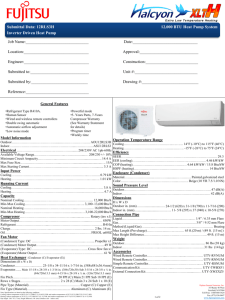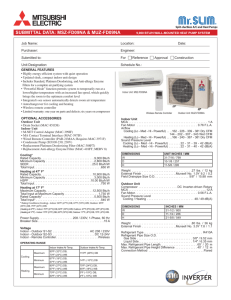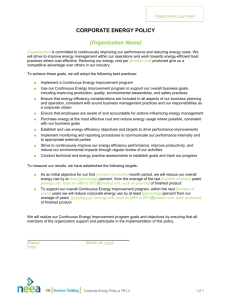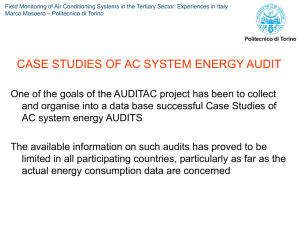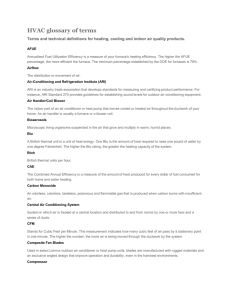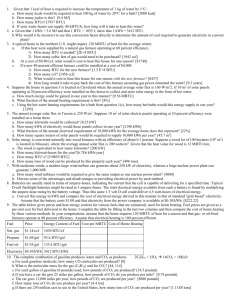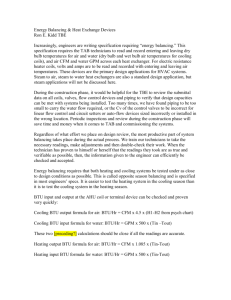Air Conditioning and Heat Pump Homework
advertisement
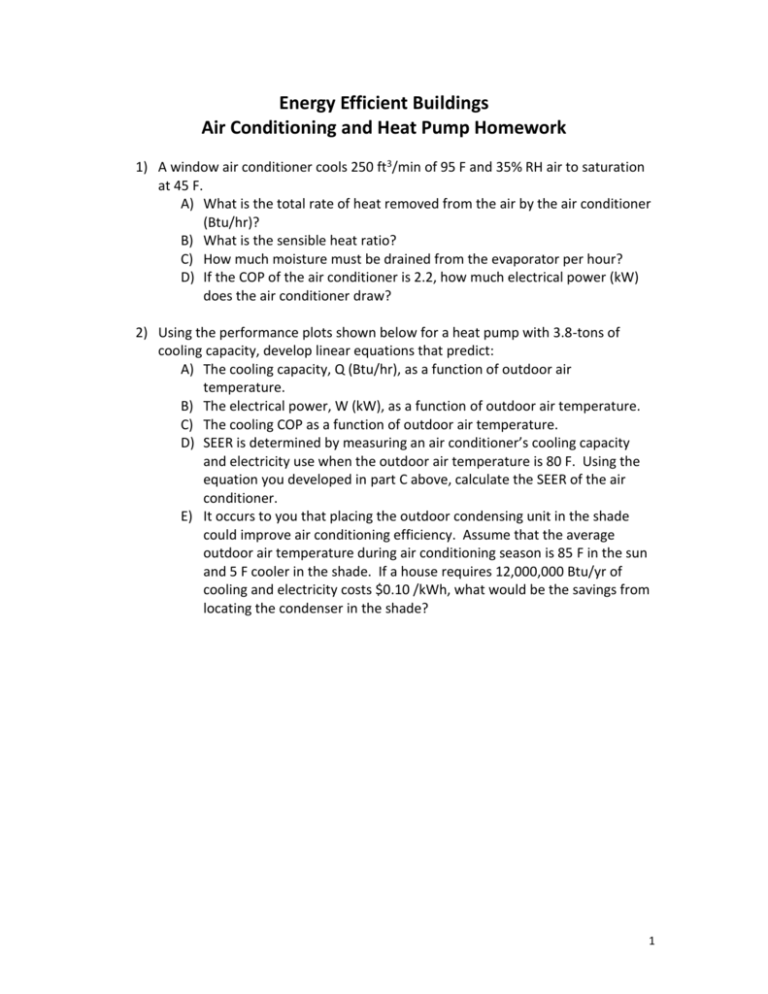
Energy Efficient Buildings Air Conditioning and Heat Pump Homework 1) A window air conditioner cools 250 ft3/min of 95 F and 35% RH air to saturation at 45 F. A) What is the total rate of heat removed from the air by the air conditioner (Btu/hr)? B) What is the sensible heat ratio? C) How much moisture must be drained from the evaporator per hour? D) If the COP of the air conditioner is 2.2, how much electrical power (kW) does the air conditioner draw? 2) Using the performance plots shown below for a heat pump with 3.8-tons of cooling capacity, develop linear equations that predict: A) The cooling capacity, Q (Btu/hr), as a function of outdoor air temperature. B) The electrical power, W (kW), as a function of outdoor air temperature. C) The cooling COP as a function of outdoor air temperature. D) SEER is determined by measuring an air conditioner’s cooling capacity and electricity use when the outdoor air temperature is 80 F. Using the equation you developed in part C above, calculate the SEER of the air conditioner. E) It occurs to you that placing the outdoor condensing unit in the shade could improve air conditioning efficiency. Assume that the average outdoor air temperature during air conditioning season is 85 F in the sun and 5 F cooler in the shade. If a house requires 12,000,000 Btu/yr of cooling and electricity costs $0.10 /kWh, what would be the savings from locating the condenser in the shade? 1 3) Using the performance plots shown above for a heat pump with 4.2-tons of heating capacity, develop linear equations that predict: A) The heating capacity, Q (Btu/hr), as a function of outdoor air temperature. B) The electrical power, W (kW), as a function of outdoor air temperature. C) The heating COP as a function of outdoor air temperature. D) For a house with an overall UA of 600 Btu/hr-F that is maintained at Ti = 70 F, find the heat pump balance-point temperature. E) The frequency of hourly temperatures for the October through March heating season in Dayton, Ohio are shown below. Using this binnedtemperature data and the house characteristics in part D, find the heating load Qenv, the heat supplied to the house by the heat pump Qhp, the auxillary heat supplied to the house by the electric resistance 2 heating elements, Qaux, the electrical energy supplied to the heat pump Whp, and the electrical energy supplied to the electric resistance heater and the heatpump Welec for the heating season. F) If electricity costs $0.10 /kWh determine the total cost of electricity for the heating system. Ta Q air W hp Ti =70F Q env Q hp Q aux ( From elec resistance heating) 4.2 ton Ta Hours H -10 <= Ta < 0 0 <= Ta < 10 10 <= Ta < 20 20 <= Ta < 30 30 <= Ta < 40 40 <= Ta < 50 50 <= Ta < 60 60 <= Ta <70 Total -5 5 15 25 35 45 55 65 17 96 359 787 1356 783 627 249 4274 Qenv h UA (Ti-Ta) (Btu) Qhp h (a+bTa) (Btu) Qaux (Qenv-Qhp)+ (Btu) 84 * 10^6 196 * 10^6 3.5*10^6 fon (Qenv/Qhp)* Whp h (c+dTa)fon (kWh) Welec Qaux+Whp (kWh) 9,300 10,400 4) Consider a house with the same overall UA of 600 Btu/hr-F and maintained at the same internal air temperature of Ti = 70 F as in the previous problem. The house has a ground-source heat pump with performance specifications shown in the text. If electricity costs $0.10 /kWh, find the annual heating energy costs assuming the Entering Fluid Temp is always 50 F. 3


